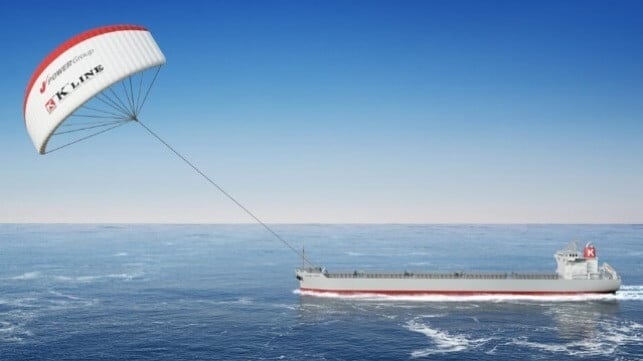Japan’s “K” Line Buys Airseas Developer of Kite Wind Propulsion System

Japanese shipping company Kawasaki Kisen Kaisha (“K” LINE) after promoting for several years the concept of a kite system to provide an element of wind propulsion to its giant bulkers reports it has purchased the company, Airseas of France, which is developing the technology. The Japanese company has been working with Airseas since 2019 and had previously placed orders for demonstration units as part of a possible deal to install the kite system on 51 vessels.
“K” Line closed the acquisition on February 15 after setting up a subsidiary in France called Oceanicwing. The company says the purpose of the acquisition, for which the price was not reported, is to strengthen the development and commercialization of “Seawing,” the automated kite system.
The companies have previously said Seawing is expected to reduce CO2 emissions from vessels by approximately 20 percent and it could be further enhanced through fuel conversion to alternatives such as LNG. They promote that the Seawing will be able to be retrofitted to any vessel and unlike rotor sails it does not require power from the ship to operate.
Airseas was started in France and after completing demonstration testing in 2017 won financial support from Airbus. The company worked on developing the technology which is an automated system that launches the parafoil wing tethered to the bow of the vessel. During flight, the technology monitors the performance, and the wing is automatically steered to maximize system power and ensure safety. They have anticipated that 100 tons of traction could be generated.
After onshore testing, the system was installed on the Ville de Bordeaux, a 5,200 dwt cargo RoRo which is operated by Louis Dreyfus Armateurs and chartered by Airbus. The ship sails transatlantic between France and the U.S. Gulf Coast transporting components for Airbus. Testing began in late 2022 with the team having both a 250 m2 version of the wing and a 500 m2 version while the commercial concept calls for a 1000 m2 parafoil, to fly at altitudes of nearly 1,000 feet capturing the stable higher altitude winds to assist vessel propulsion.
During the first tests, they validated the systems including the launch, take-off, ascent, descent, and landing. They reported that the Seawing was flying more than 650 feet above sea level. After further testing, they reported in May 2023 that they had successfully generated one ton of traction and by October 2023 they had successfully completed validation testing.

that matters most
Get the latest maritime news delivered to your inbox daily.
“K” Line had announced that it expected to begin testing the Seawing on one of its large vessels in 2022 followed by plans to put the first systems on a vessel by 2024. They had projected the system would go into commercial production by 2024.
JFE Steel had announced plans to build and operate two 210,000 dwt vessels due for delivery in 2024 and 2025 outfitted with the Seawing. The first LNG-fueled bulk carrier being built by Nihon Shipyard Co. to be operated by “K” Line was also expected to incorporate the technology. Louis Dreyfus Armateurs and Airbus, however, which participated in the validation trails of the Seawing, recently announced they are building three large cargo RoRos and chose instead to incorporate the Norsepower rotors to provide wind-assisted propulsion.
